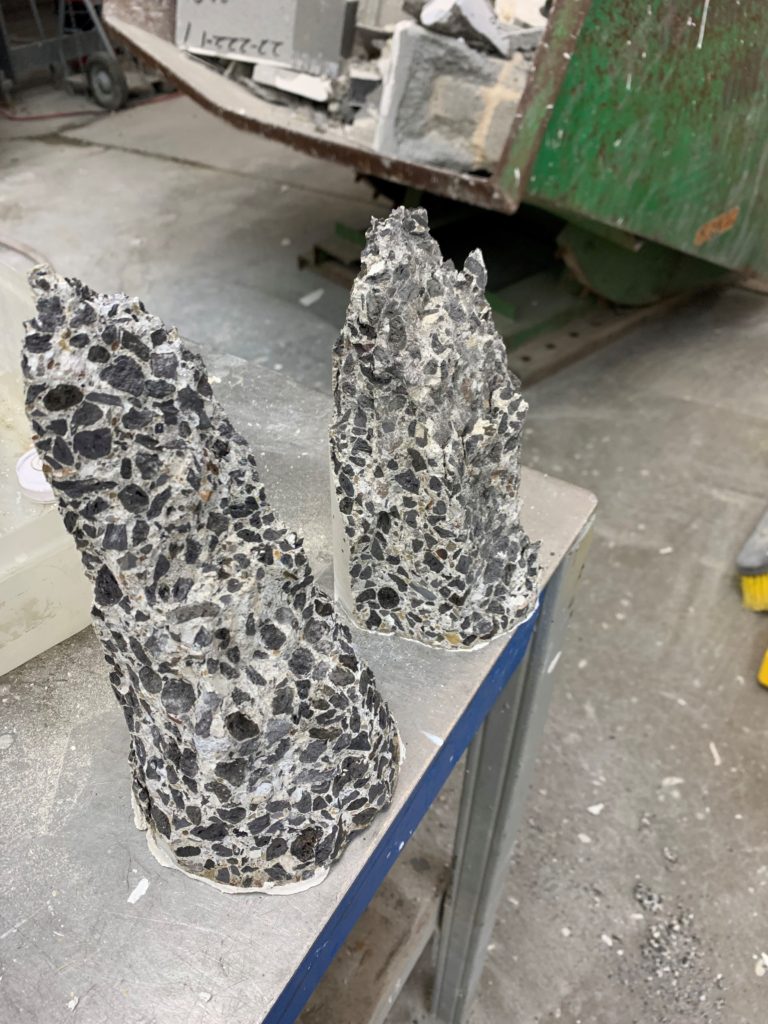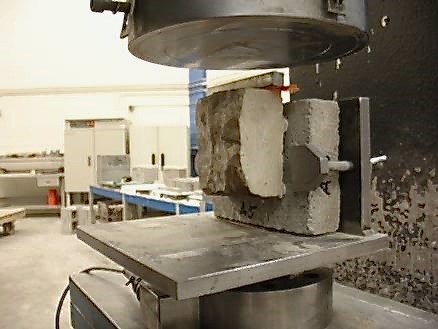ASTM C1670: Seeing a Standard Grow to Maturity
Words: Jeff Tew
Words: Jeff Tew, Director of Technical & Training, Westlake Royal Stone Solutions
Photos: Westlake Royal Stone Solutions, NCMA Laboratory
My sons recently asked me to allow them to save up and buy a hoverboard. They begged and pleaded for an opportunity to buy something that sounded amazing and fun and that a lot of their friends already owned. Mind you, this is not the Back to the Future idea of a hoverboard; it’s actually more of a two-wheeled death machine—just search something like “adult on a hoverboard” on YouTube, and you’ll be instantly convinced to ban them from your home. Although somehow, the younger generation seems to learn much more quickly, with far fewer accidents and incidents.
In the interest of keeping my boys happy, I decided to research these toys that my kids were so desperate to buy, starting with the rechargeable batteries. Underwriters Laboratory sets the standard for electronics, so I spent a fair amount of time looking into the UL certification of each battery. I found that many of the more economical choices lacked UL certification, and I knew I would never hear the end of it from my wife if I chose a more “cost effective” option with a faulty battery that then had some unexpected issue with one of our boys cruising on top.
My point in sharing this story is to say that standards are important, not only for end-users but also for everyone involved in the process of getting materials and products into position for effective everyday use.
AC 51: Setting a Standard for MSV
Building codes provide standards and outline minimum requirements for many of the products used in the construction industry. These codes also allow the building official to consider alternative materials and methods for achieving the desired look, feel and function of a building or space. There are a number of evaluation service companies that develop Acceptance Criteria (AC) for materials that may be newer to the market and/or not addressed directly in the building code. They do so by compiling technical and application information on a product, then comparing those details to existing codes in order to understand how the code might impact the use of that new product.
The AC develops guidelines and quality consistency requirements during this evaluation process that may eventually become code standard. However, for many years, the only way to determine if a given product was potentially suitable for consideration was to investigate whether or not the manufacturer had conducted testing via a third party such as IAPMO, ICC-ES, ICBO or NES. Without some testing, project managers and end-use consumers had nothing to depend on apart from any given manufacturer’s internal quality controls and warranties.
In the case of MSV, it wasn’t until 2008 that we saw the early acceptance criteria known as AC 51, bringing the first movement toward unified testing consistency to the MSV industry. AC 51 applied ASTM testing methods commonly used for stucco and brick for material evaluation methods. Following its publication, AC 51 then underwent a multi-year evaluation period of its own, during which time the evaluation service companies continued to make adjustments to their testing methods, criteria and reporting/evaluation metrics as needed.
All of this important work laid the foundation for additional standardization for the MSV market and the ongoing development of ASTM C1670.
ASTM C1670: Manufacturers’ Path to Code Acceptance
After moving through the Acceptance Criteria phase, many products then move ahead and become involved with an ASTM standard. ASTM International, formerly known as the American Society for Testing and Materials, writes these standards to be adopted into the building code over time. Unlike the evaluation service companies, ASTM is a consensus developed document, meaning it will have input from individuals with a wide array of interests, including producers, users, industry experts and others.
For MSV, the Masonry Veneer Manufacturers Association (now the National Concrete Masonry Association, or NCMA) initiated the beginning work toward an ASTM standard in 2007. In 2013, ASTM C1780 was developed to address the methodology for any installation of MSV, while ASTM C1670 was concurrently developed to address the minimum physical property requirements to be used when manufacturing MSV products. Beginning in 2018, ASTM C1670 was adopted into the IBC and IRC codes, and it is referenced in AC 51 now as well. This ensures that manufacturers have a clear pathway to code acceptance for their products, specifically by demonstrating compliance with the requirements of ASTM C1670.
In terms of manufactured stone veneer (MSV), ASTM C1670 is an incredible standard that provides guidance and direction for trade professionals who are looking to approach projects the right way with quality products that are manufactured to stand the test of time. It was created by a team of thoughtful, intelligent experts in construction and related industries. Most importantly, it establishes clear guidelines for MSV manufacturers to demonstrate compliance in their materials. As more states and local municipalities adopt the 2018 building codes and beyond, the requirement for a material to meet ASTM C1670 in the Adhered Masonry Veneer section will become more recognized and enforced by code officials.
How Testing Happens
Builders and contractors will be looking to product manufacturers more and more to demonstrate adherence to the standard, which then establishes confidence in the long-term use and durability of the MSV profiles themselves. So what does it look like for manufacturers to test products and establish compliance with ASTM C1670?
The Labs
ASTM C1670 describes specifically how testing should be conducted on products in terms of what type of unit, what type of environment and with what frequency. Some must be completed every 12 months, while others are every 24 months. Because the standard is written with such clarity, many different labs can conduct the necessary tests and work with the manufacturer in a variety of ways. For example, some labs will work with manufacturers to show a chain of custody for all materials that require testing, while other labs will obtain and mix the raw materials themselves to make the necessary beams for testing in addition to randomly sampled MSV units.
Ensuring that products are tested properly is very important. The lab chosen should be able to demonstrate they have competent technicians, proper equipment, and procedures in place to ensure quality. Labs demonstrate this through accreditation, where a third party comes in to audit quality operations. Accreditation is based on adherence to quality standards, such as ISO 17025 and/or ASTM C1093. These standards provide requirements for the quality control systems in labs. As an example, ISO 17025 requires that labs have procedures on how to train technicians to perform tests correctly, and the lab must document this is followed. These procedures ensure testing is done in accordance with established test methods. In short, utilize labs that are accredited for the specific test methods they will perform. (As a side note, ASTM C1093 is a quality standard specific for labs that test masonry.
The Tests
To comply with ASTM C1670, there are a number of tests required, some of which must be done on MSV stones and others that must be completed using specimens molded from fresh concrete used to make units. To ensure compliance, labs must test products in specific sizes and shapes within prescribed testing machines, and molded specimens are sometimes the only medium for achieving those particular dimensions.
Here are three examples of important tests required under ASTM C1670:
- Compressive Strength: Of all the tests, this one is by far the crowd pleaser. It’s visually satisfying and does not take as long as many of the other tests. For this test, five 4”x8” cylinders are manufactured and left undisturbed for 48 hours, then demolded after seven days and fully tested when they are 28 days old (in accordance with ASTM C39/C39M). The finale is a loud pop when the cylinder shears, explodes and breaks into pieces from the application of hydraulic pressure. For ASTM C1670 compliance, the minimum compressive strength is 2100 psi.
 The compressive strength test is conducted in a laboratory to comply with the minimum compressive strength of 2100 psi. Source: Westlake Royal Stone Solutions
The compressive strength test is conducted in a laboratory to comply with the minimum compressive strength of 2100 psi. Source: Westlake Royal Stone Solutions- Freeze/Thaw Durability: While this test is not as visually entertaining, it’s no less important. For regions such as northern states and Canada that experience temperature swings and multiple freeze/thaw cycles in a single day, this test is particularly crucial. The ultimate goal of this test, which involves submerging an air cured beam in water for 50 consecutive freeze/thaw cycles, is to ensure that the lightweight concrete mix of the MSV will be able to withstand expansion and contraction of freezing and thawing water without damaging the stone. In order to pass this test, the units cannot have a mass loss greater than 1.5 percent or show any fractures through the beam.
- Shear Bond: This test uses manufactured units rather than molded specimens, and its goal is to ensure that the MSV units are able to develop a shear bond strength of at least 50 psi with mortar used to adhere it to the substrate. In this test, five different units are cut to a minimum of 2.25”x2.25” up to a maximum of 4”x4”, and a specific mortar mix is used to bond to the back of the units, then cured for seven days. The units themselves must have been cured for a minimum of 28 days. After the appropriate time has passed, the unit and mortar get placed inside the testing apparatus, featuring a ½”x½” steel bar that is long enough to extend beyond both edges and is placed on top of the stone. To confirm that the unit is able to achieve the minimum shear bond strength requirement and test for a breaking point, the apparatus then applies downward force on the steel bar until failure.
 The shear bond test ensures that MSV is able to develop a bond strength of at least 50 psi with the mortar used to adhere it to the substrate. Source: NCMA Laboratory
The shear bond test ensures that MSV is able to develop a bond strength of at least 50 psi with the mortar used to adhere it to the substrate. Source: NCMA LaboratoryMasonry adds resilience, beauty and a sense of permanence to any project and is one of the most prolific building materials on the planet. Since its initial creation in the 1960s, MSV has provided a variety of new textural and visual options for specifiers and consumers to consider, and the standardization of ASTM C1670 (along with related codes and guidance such as AC 51) has done much to solidify MSV’s presence and viability in today’s building ecosystem.
Like the UL certification, I considered a “Must Have” for my boys’ hoverboard battery. Standards such as ASTM C1670 and ASTM C1780 should serve as your north star whenever you are selecting and installing MSV for a new project.
About the Author
As the Director of Technical and Training for Westlake Royal Stone Solutions, Jeff Tew is an invaluable thought leader and resource for trade professionals. With more than 25 years of career experience in Manufactured Stone Veneer (MSV), he works with masons, builders, architects and others in the construction industry to help design and build beautiful projects.